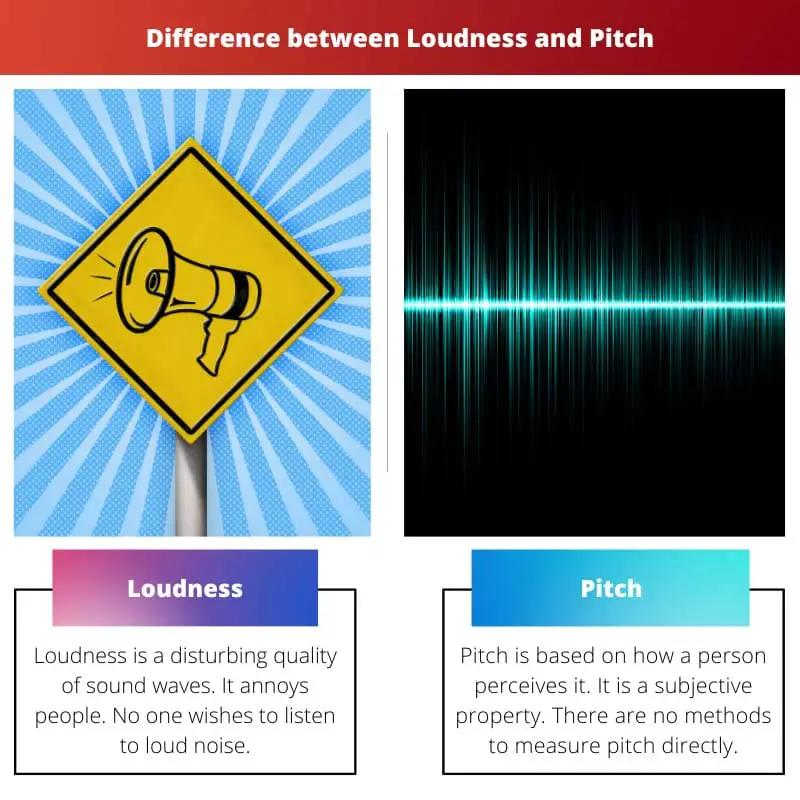The vibration of different objects produces Sound. It travels through any medium. We detect these sound waves with our ears. Ears detect the intensity of sound waves.
Based on the Intensity, sound can be annoying or enjoyable. Music generated by instruments soothes the mind. Our brain enjoys music. But, loud noises are intolerable.
Key Takeaways
- Loudness is the subjective perception of a sound’s intensity or volume, while pitch refers to the perceived frequency of a sound experienced as high or low.
- Loudness is measured in decibels (dB), whereas pitch is measured in hertz (Hz).
- Both loudness and pitch contribute to how humans perceive and differentiate sounds, but they describe different qualities of sound waves.
Loudness VS Pitch
Loudness refers to the subjective perception of the intensity of sound by the human ear, measured in decibels. Pitch, on the other hand, is the perceived frequency of a sound, determining whether we perceive it as high (“sharp”) or low (“flat”) on the musical scale.

The loudness of sound is perceived based on a different characteristic. Pressure level, Duration, and Frequency content affect loudness.
Loudness indicates that the sound waves are not bearable. Loud noises affect the eardrums. It causes hearing loss. Exposure to loud noise permanently affects hearing in some people.
A sound wave is considered low or high based on the Pitch. It is associated with the vocals of melody singers. Pitch is one of the main attributes of a musical tone.
Some people quantify Pitch as frequency. Listeners assign a Tone on a scale based on how they perceive it. In singing, High notes have a high pitch. Pitch cannot be measured directly. It depends on how each person perceives it.
Comparison Table
| Parameters of Comparison | Loudness | Pitch |
|---|---|---|
| Units | Sone, Phon | Mels |
| Character | Sound waves with high energy | Highness or lowness |
| Perception | It is perceived as annoying | Thrilling or amusing |
| Generated by | Machinery | Singers and musical instruments |
| Use | Used in DJ parties | In Music Industry |
What is Loudness?
Loudness is a disturbing quality of sound waves. It annoys people. No one wishes to listen to loud noise. An audiometer measures the loudness of a sound.
This instrument makes use of an ear balance. Sine wave adjustment helps to identify the loudness.
Loudness cause temporary or permanent damage to the eardrum. People with hearing impairment cannot sense sounds at low levels.
Hearing-impaired people cannot hear low sounds. But, they can perceive loud noise just like normal people. Softness imperfection or loudness recruitment is this phenomenon.
Loudness is perceived rapidly by some listeners. It affects the normal functioning of animals.
Some people perceive the soft sounds to be loud. The term called softness imperception denotes this phenomenon. The loudness compensation feature applied to some stereos helps to make the music more natural.
Boosting low frequencies is carried out by these stereos. Loudness normalization makes commercials sound exactly like TV shows.
Machines in industries generate loud noises. Loudness is prohibited in hospital areas as it can cause distress to patients.
Music streaming platforms like iTunes and Spotify employ this technique. Netflix also make use of this technique. Loudness is measured in terms of sone and phone units.
Listening tests sponsored by broadcasters involve, subjects listening to a sound. It helps to categorize noises as loud or quiet. Loudness affects birds. It is a reason for not lighting crackers near sanctuaries.

What is Pitch?
Pitch is based on how a person perceives it. It is a subjective property. There are no methods to measure pitch directly. But, the unit mels helps to measure Pitch using indirect methods.
People can distinguish between high and low pitches. Pitch allows you to order sounds on a scale. Low to high-pitched sounds can be organized on a scale.
The speed of a vibration made by a sound gives Pitch. High-pitched sounds oscillate rapidly. Slower oscillation corresponds to low pitch.
Humans can perceive the vertical increase or decrease of a sound in space when the frequency of the sound changes. Some observers perceive more than one pitch at the same time. When sound pressure increases, Low tones lower in Pitch.
Several theories were proposed to explain the perception of pitch. These theories are of two types, place coding and temporal coding.
The place theory states that the pitch of a sound or voice depends on the place of excitation. It depends on the maximum excitation of the basilar membrane.
The tonotopic region in the brain helps in perceiving pitch. Primates lacking this region also respond to high and low pitches. It proves that this region is not entirely responsible for pitch detection.
Temporal theories show that temporal structures are responsible. Sound with definite pitch is harmonic. People can distinguish this type of sound. Indefinite pitch is hard to identify. It lacks harmonicity.
Main Differences Between Loudness and Pitch
- Loudness is a trait of sound. It distinguishes a sound noise from a quiet sound. Pitch defines the highness or lowness of a sound. The clear pitch is harmonic.
- Loudness depends on the intensity of a sound. It depends on the energy of the sound wave. Pitch is determined by how a listener perceives a sound
- Loud noises disturb hearing. Loudness can cause hearing impairment. High-pitched noises are sharp.
- The units of measurement of loudness are sone and phon. Unit of Pitch is mels
- Features for adjusting loudness are available in stereos. This helps to enhance the quality of music. High pitched voices in a song provoke thrills and cause goosebumps

- https://onlinelibrary.wiley.com/doi/abs/10.1002/ajmg.1320290405
- https://books.google.com/books?hl=en&lr=&id=0unDEd5fAgcC&oi=fnd&pg=PA187&dq=loudness+&ots=NUlGAeNtd9&sig=iXQjVKZCgSVf_RzaDzEUfVt98GE
